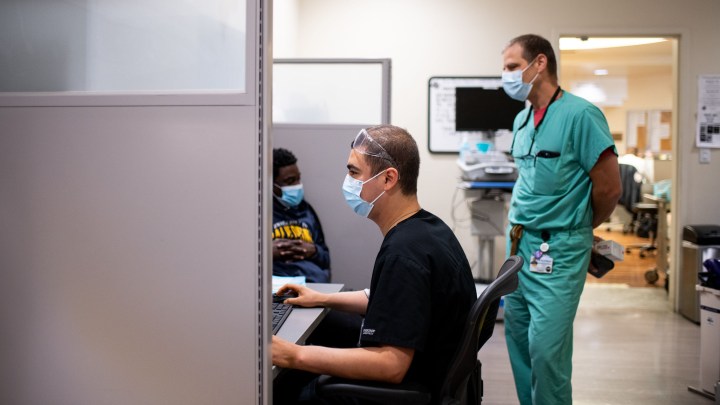
California invests millions to try and curtail drug overdoses
California invests millions to try and curtail drug overdoses

Doctors and caregivers are racing to help patients access treatment at Highland Hospital in Oakland. A stream of patients rolls off ambulances and inside the ER nurses dart between beds.
“The patient presents with mild opioid and benzo withdrawal system symptoms,” said Christian Hailozian, a substance use navigator, as he reviews the chart of a recent arrival. “Irritability, tremors, sweating, last used fentanyl, crack cocaine, Xanax at noon yesterday.”
The pandemic has exacerbated the country’s opioid crisis. More than 100,000 people in the United States died from drug overdoses last year — an average of about 250 people a day. That’s the highest one-year death toll on record.
California is pouring millions of dollars into a new statewide program called California Bridge, and it’s becoming a model for the rest of the country.
Hailozian’s job, which is funded through the program, is to help people who do drugs navigate the health care system. “Just letting them know it’s OK,” he said. “We got you. We’re going to try and do the most for you right now.”
He can help with everything from getting someone signed up for insurance to connecting them to a treatment facility.
“We’ll go see this patient in room 17,” Hailozian said.
A woman in her 60s named Sonia slowly pushes herself up to her elbows. We are not using her last name because of the stigma around addiction. She’s sweating profusely.
“So you started getting nauseous and you started having a runny nose?” Hailozian asked.
“And I started going… ehhh,” says Sonia. “I’ve been sick, throwing up from both ends.” Sonia said she blacked out playing Bingo the night before.
“Withdrawal symptoms, opioid withdrawal symptoms, classic,” Hailozian said.
An ER doctor peeks in to give Sonia a low dose of buprenorphine. The small white pills are one of three federally approved drugs to ease withdrawal symptoms and cravings for a day or two. Sonia brightens up almost immediately.
Medically assisted treatment is a key California Bridge approach and part of a statewide push to make it more widely available.
“It lowers mortality risk by about 50%,” said Monish Ullal, an internal medicine doctor at Highland and a substance abuse expert. “There’s very little in medicine that has that big of an impact on a person’s chances of dying.”
Studies show that patients who receive opioid meds in the ER are twice as likely to remain in treatment a month later compared to someone who doesn’t. But only about 20% of ER doctors in the U.S. are trained to dispense them.
Some patients and doctors are skeptical about an opioid alternative.
“Patients will ask, ‘How long am I going to stay on this medication? How soon can I get off?’ And then doctors are asking too, ‘Aren’t you just replacing one drug for another?’ They’re stuck on the buprenorphine, too,’” Ullal said.
But he said that’s true for lots of diseases, like high cholesterol and high blood pressure, which require lifelong medications. Ullal said addiction is a brain disease that requires specific ongoing medication. At Highland Hospital, doctors dispense opioid dependency meds on demand.
The state invested $20 million into California Bridge last fall to expand the model. Now about 40% of hospitals are enrolled. The state’s goal is to increase that tally to 100% by 2025.
Hailozian checks on a patient in the hospital’s treatment clinic. “Why’d you come here today?” asked Hailozian. “What can we help you with?”
“My sobriety,” Drew said. We are using only his first name because of his illegal drug use. “To get clean basically, to get off heroin and meth.”
Drew is 36 years old and lives on the streets. He often lands in the ER after an overdose. A doctor delivers a couple of blue methadone pills to Drew.
Drew said withdrawal medications are crucial to helping him break his addiction.
“I’m not going to lie. I would have definitely stayed using drugs. I wouldn’t see the point or put myself through the withdrawals,” said Drew, who recently enrolled in an in-patient substance use program. “The option of buprenorphine is helping a lot of people like me get off drugs. Because it’s pure hell for me. I experience withdrawals for like forever.”
Drew’s eyes roll back as the methadone starts to hit. He said today is a success, because he didn’t shoot heroin.
There’s a lot happening in the world. Through it all, Marketplace is here for you.
You rely on Marketplace to break down the world’s events and tell you how it affects you in a fact-based, approachable way. We rely on your financial support to keep making that possible.
Your donation today powers the independent journalism that you rely on. For just $5/month, you can help sustain Marketplace so we can keep reporting on the things that matter to you.

















